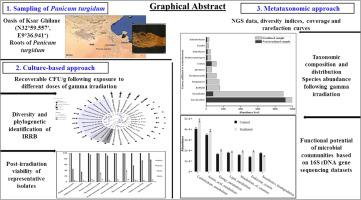Saudi Journal of Biological Sciences ( IF 4.4 ) Pub Date : 2021-09-16 , DOI: 10.1016/j.sjbs.2021.09.020 Sihem Guesmi 1, 2 , Afef Najjari 3 , Petar Pujic 4 , Kais Ghedira 5 , Rania Ouertani 6 , Marwa Jabberi 2, 7 , Ameur Cherif 6 , Philippe Normand 4 , Haïtham Sghaier 2, 6

|
Bacterial communities associated with roots of Panicum turgidum, exposed to arid conditions, were investigated with a combination of cultural and metataxonomic approaches. Traditional culture-based techniques were used and 32 isolates from the irradiated roots were identified as belonging to Actinobacteria, Bacteroidetes, Firmicutes and Proteobacteria phyla. Four actinobacterial strains were shown to be ionizing-radiation (IR)-resistant: Microbacterium sp. PT8 (4.8 kGy (kGy)), Micrococcus sp. PT11 (4.4 kGy), Kocuria rhizophila PT10 (2.9 kGy) and Promicromonospora panici PT9T (2.6 kGy), based on the D10 dose necessary for a 90% reduction in colony forming units (CFU). Concerning the investigation of microbial communities in situ, metataxonomic analyses of the diversity of IR-resistant microorganisms associated with irradiated roots revealed a marked dominance of Actinobacteria (46.6%) and Proteobacteria (31.5%) compared to Bacteroidetes (4.6%) and Firmicutes (3.2%). Gamma irradiation not only changed the structure of bacterial communities, but also affected their functional properties. Comparative analyses of metabolic profiles indicated the induction of several pathways related to adaptation to oxidative stress in irradiated roots, such as DNA repair, secondary metabolites synthesis, reactive oxygen species (ROS)-mitigating enzymes, etc. P. turgidum is emblematic of desert-adapted plants. Until now, there is no other work that has focused on the microbial profile of irradiated roots of this xerophyte.
中文翻译:

旱生植物 Panicum turgidum 的根部拥有一群具有生物技术价值的抗电离辐射细菌
结合文化和元分类学方法研究了暴露于干旱条件下与Panicum turgidum根相关的细菌群落。使用传统的基于培养的技术,从辐照根中分离出 32 个分离物被鉴定为属于放线菌门、拟杆菌门、厚壁菌门和变形杆菌门。四种放线菌菌株被证明具有电离辐射 (IR) 抗性:Microbacterium sp。PT8 (4.8 kGy (kGy)), Micrococcus sp. PT11 (4.4 kGy)、Kocuria rhizophila PT10 (2.9 kGy) 和Promicromonospora panici PT9 T (2.6 kGy),基于 D 10菌落形成单位 (CFU) 减少 90% 所需的剂量。关于原位微生物群落的研究,对与辐照根相关的耐红外线微生物多样性的元分类学分析显示,与拟杆菌门(4.6%)和厚壁菌门(3.2%)相比,放线菌门(46.6%)和变形杆菌门(31.5%)具有显着优势。 %)。伽马射线照射不仅改变了细菌群落的结构,而且影响了它们的功能特性。代谢特征的比较分析表明,在辐照根中诱导了几种与适应氧化应激相关的途径,例如 DNA 修复、次生代谢物合成、活性氧 (ROS) 缓解酶等。是适应沙漠的植物的象征。到目前为止,还没有其他工作专注于这种旱生植物辐照根部的微生物特征。



























 京公网安备 11010802027423号
京公网安备 11010802027423号